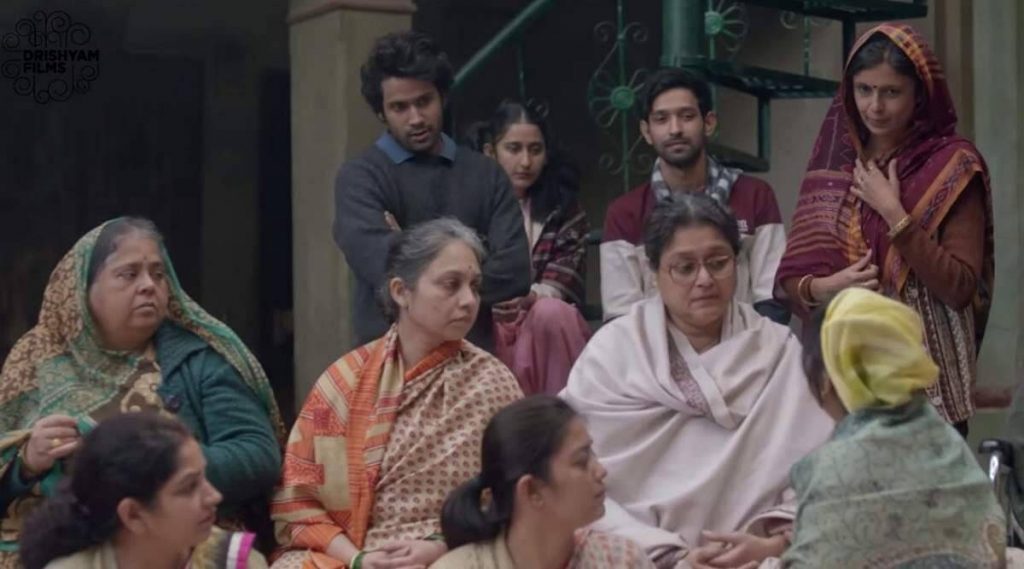Set during the ‘13 days of mourning’ after the death of the family patriarch, Ramprasad Bhargava (Naseeruddin Shah), Seema Pahwa’s directorial debut, Ramprasad Ki Tehrvi, deals with a large family that gathers to grieve together. The film explores the frailty of the familial system as it exposes the flaws, wounds, regrets and unexpressed emotions of the various family members.
Most of the drama in Ramprasad Ki Tehrvi unfolds within the confines of the architectural space of Ramprasad’s home in Lucknow as his six children and various other relatives congregate from various parts of the country to partake in the seemingly doleful event of the aftermath of his demise. What ensues thereafter is a mix of highs and lows, comedy and tragedy and tumbling out of various skeletons from different cupboards. Even as the family strives to get through the strenuous ritualistic days, the sudden discovery of a huge loan owed to the bank by their deceased father hit them in the gut. And now they have no choice but to take on this liability and try to pay it off…
The premise is not something new as enough films have used the trope of family and relatives meeting following the death of a family member and we then see the drama that follows. And through her characters’ crises, Pahwa attempts to represent issues of familial discords, which are closeted within rigid societal structures. Depicting the financial hardship of a middle-class family and questioning the moral world of the family as an institution, Pahwa has also displayed the duplicity implicit in such apparent harmonious homes. But again, we have seen this many times before. The film, therefore, needed to be more novel and original in its treatment of rather familiar material to stand out and this is where it stumbles. While no doubt perceptive and observant in her exploration, Pahwa is unable to uniquely treat the situation in a manner to let it rise above its recognizable material. She treats the film as slice-of-life moments rather than a conventional tightly knitted narrative, and there is no issue with that. But the problem is that it all fails to coherently come together and some of the scenes and sequences continue to stay far too much in isolation rather than layer itself within the larger picture. The setup and the payoffs that follow are dealt with in a far too straightforward manner due to which the proceedings are not very engaging, thereby making it difficult for us to invest in the on-screen happenings. Even as she uses simplicity as a form, sadly, it is not utilized well enough to develop an interesting crux in its exploration of the various dynamics between the many, assorted characters. They have no complexity to their traits that viewers might eagerly want to explore for themselves, thereby lending the film the feel of serving the viewer an under-cooked story.
Thankfully, Pahwa populates her story with a cast of highly talented actors who bring some nuance and multi-dimensionality to their characters. However, the ensemble cast is both the merit and demerit of the film because the filmmaker fails to do justice in providing a convincing, well-fleshed out characterization to some of them in the approximately two hours running time of the narrative . If the casting of the film had been more limited, perhaps the viewers could have developed more empathy for some of them. While the entire cast tries gamely to make the most of what they’ve got, Parambrato Chatterjee and Konkana Sensharma, dealing with their struggling relationship, work best in the film. The director has also invested enough time in the screenplay to properly flesh out these two characters with a proper backstory and all. Sensharma plays a struggling actress, who had an abortion for the sake of her career, that incident becoming one of the reasons for their strained marital life. She also has a none-too-amicable relationship with her in-laws. Chatterjee, the youngest amongst the brothers, had also financially helped his elder brothers whenever they were in need. As the film heads towards the climax, he delivers one of the most effective lines of the film when he points out that after the death of their father, his elder brothers are now suddenly saddled with the burden of responsibility, which, in a way, encapsulates the theme of the film.
Regarding the technical aspects, all the departments are adequate but the biggest disappointment comes from Pahwa’s choice of the songs within the film and their placement. Especially in the scene of the film involving the four brothers having a drink on a wintry night and reliving memories from the past. While this is one of the most emotionally touching and poignant sequences in the film, the sudden intrusion of a playback song derails the moment completely.
The climactic image of the film, also a recurring one, that of an electrician fixing a faulty line climbing on the pole symbolizes the whole circular process of life and death. It tells us that all problems and hurdles from the past will ultimately transform into beautiful memories. But for all the strong statement it makes, it is unable to save the film from falling into the gallows of disengagement. And that is its biggest failure.
Hindi, Drama, Color


